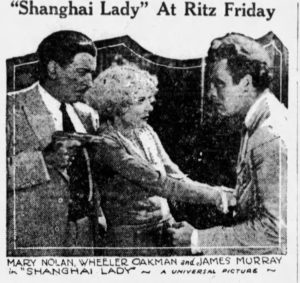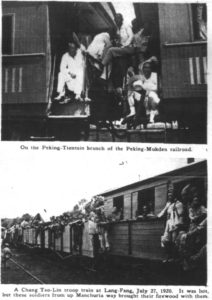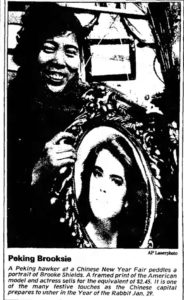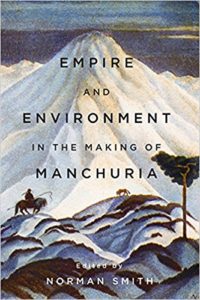Posted: June 12th, 2017 | No Comments »
A big thank you to the travel correspondent of the Chicago Tribune in 1935 who advised the following…

The “Native City” is what is now generally referred to as “old town” (or Nantao, or a variant). It is less of a shock these days unless, of course, you are a lover of traditional Chinese architecture, treaty port architecture or historical preservation in general in which case its destruction is so shocking as to make you lie down and weep….
Posted: June 9th, 2017 | No Comments »
Made in 1929, Shanghai Lady mostly played in cinemas in 1930. The character plaayed by James Murray was called ‘Badlands’ McKinney, which obviously I love.

Posted: June 8th, 2017 | No Comments »
I came across this wonderful advert from 1934 for Ann Bridge’s novel of Peking ex-pat life The Ginger Griffin…if you haven’t read it then do.
Odd though that they should choose to stress that The Ginger Griffin is “far richer” than her first, Peking Picnic – which is also a fantastic novel and sold plenty and won prizes.

Posted: June 7th, 2017 | No Comments »
In October 1920 Chang Tso-lin’s (Zhang Zuolin) troops were advancing on Peking. These interesting photos show how they used the Mukden (Shenyang)-Peking train line to speed their arrival…

Posted: June 6th, 2017 | 3 Comments »
A curio of a story from 1987 – it’s a Chinese New Year, Janurary – the Year of the Rabbit is being ushered in. Among the many wonders Pekingers can now buy is a rather elaborately framed picture of Brooke Shields – and just $2.45 (though I suspect this canny lady wasn’t taking FEC) – it is just about within the realms of possibility that this still adorns a hutong wall somewhere….

Posted: June 5th, 2017 | No Comments »
Norman Smith edits this fascinating deep dive into the notion of Manchuria as China’s great adventurous expanse….Empire and Environment in the Making of Manchuria…

This unique and compelling analysis of Manchuria’s environmental history demonstrates how the region’s geography shaped China’s past. Since the seventeenth century, the call of the Manchurian wilderness, with its abundant wildlife, timber, and mining deposits, has led some of the greatest empires in the world to do battle for its riches. Chinese, Japanese, Manchu, Russian, and other imperial forces have defied unrelenting summers and unforgiving winters as they fought for sovereignty over this vast “frontier.”
Until now, historians have focused on rivalries between Manchuria’s colonizing forces. Empire and Environment in the Making of Manchuria examines the interplay of climate and competing imperial interests in the region’s vibrant – and violent – cultural narrative. Families that settled this borderland reaped its riches while at the mercy of an unforgiving and hotly contested landscape.
As China’s strength as a world leader continues to grow, this volume invites further exploration of the indelible links between empire and environment. The role of Manchuria in China’s social and political evolution provides context for understanding how the geopolitical future of this global economic powerhouse is rooted in its past.
Norman Smith is a professor of history at the University of Guelph. He is the author of Intoxicating Manchuria: Alcohol, Opium, and Culture in China’s Northeast and Resisting Manchukuo: Chinese Women Writers and the Japanese Occupation, which was awarded the Canadian Women’s Studies Association 2008 Book Prize.
Contributors: David A. Bello, Blaine Chiasson, Annika A. Culver, Loretta E. Kim, Diana Lary, Kathryn Meyer, Wang Ning, Norman Smith, Ronald Suleski, and Sun Xiaoping.
Posted: June 4th, 2017 | No Comments »
Sorry I’m so late blogging this but if you’re in New York it should be of interest…..









